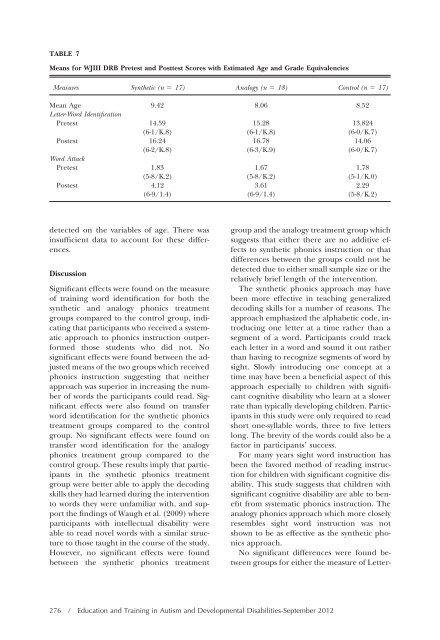etadd_47(3) - Division on Autism and Developmental Disabilities
etadd_47(3) - Division on Autism and Developmental Disabilities
etadd_47(3) - Division on Autism and Developmental Disabilities
You also want an ePaper? Increase the reach of your titles
YUMPU automatically turns print PDFs into web optimized ePapers that Google loves.
TABLE 7<br />
Means for WJIII DRB Pretest <strong>and</strong> Posttest Scores with Estimated Age <strong>and</strong> Grade Equivalencies<br />
Measures Synthetic (n 17) Analogy (n 18) C<strong>on</strong>trol (n 17)<br />
Mean Age 9.42 8.06 8.52<br />
Letter-Word Identificati<strong>on</strong><br />
Pretest 14.59 15.28 13.824<br />
(6-1/K.8) (6-1/K.8) (6-0/K.7)<br />
Postest 16.24 16.78 14.06<br />
(6-2/K.8) (6-3/K.9) (6-0/K.7)<br />
Word Attack<br />
Pretest 1.83 1.67 1.78<br />
(5-8/K.2) (5-8/K.2) (5-1/K.0)<br />
Postest 4.12 3.61 2.29<br />
(6-9/1.4) (6-9/1.4) (5-8/K.2)<br />
detected <strong>on</strong> the variables of age. There was<br />
insufficient data to account for these differences.<br />
Discussi<strong>on</strong><br />
Significant effects were found <strong>on</strong> the measure<br />
of training word identificati<strong>on</strong> for both the<br />
synthetic <strong>and</strong> analogy ph<strong>on</strong>ics treatment<br />
groups compared to the c<strong>on</strong>trol group, indicating<br />
that participants who received a systematic<br />
approach to ph<strong>on</strong>ics instructi<strong>on</strong> outperformed<br />
those students who did not. No<br />
significant effects were found between the adjusted<br />
means of the two groups which received<br />
ph<strong>on</strong>ics instructi<strong>on</strong> suggesting that neither<br />
approach was superior in increasing the number<br />
of words the participants could read. Significant<br />
effects were also found <strong>on</strong> transfer<br />
word identificati<strong>on</strong> for the synthetic ph<strong>on</strong>ics<br />
treatment groups compared to the c<strong>on</strong>trol<br />
group. No significant effects were found <strong>on</strong><br />
transfer word identificati<strong>on</strong> for the analogy<br />
ph<strong>on</strong>ics treatment group compared to the<br />
c<strong>on</strong>trol group. These results imply that participants<br />
in the synthetic ph<strong>on</strong>ics treatment<br />
group were better able to apply the decoding<br />
skills they had learned during the interventi<strong>on</strong><br />
to words they were unfamiliar with, <strong>and</strong> support<br />
the findings of Waugh et al. (2009) where<br />
participants with intellectual disability were<br />
able to read novel words with a similar structure<br />
to those taught in the course of the study.<br />
However, no significant effects were found<br />
between the synthetic ph<strong>on</strong>ics treatment<br />
group <strong>and</strong> the analogy treatment group which<br />
suggests that either there are no additive effects<br />
to synthetic ph<strong>on</strong>ics instructi<strong>on</strong> or that<br />
differences between the groups could not be<br />
detected due to either small sample size or the<br />
relatively brief length of the interventi<strong>on</strong>.<br />
The synthetic ph<strong>on</strong>ics approach may have<br />
been more effective in teaching generalized<br />
decoding skills for a number of reas<strong>on</strong>s. The<br />
approach emphasized the alphabetic code, introducing<br />
<strong>on</strong>e letter at a time rather than a<br />
segment of a word. Participants could track<br />
each letter in a word <strong>and</strong> sound it out rather<br />
than having to recognize segments of word by<br />
sight. Slowly introducing <strong>on</strong>e c<strong>on</strong>cept at a<br />
time may have been a beneficial aspect of this<br />
approach especially to children with significant<br />
cognitive disability who learn at a slower<br />
rate than typically developing children. Participants<br />
in this study were <strong>on</strong>ly required to read<br />
short <strong>on</strong>e-syllable words, three to five letters<br />
l<strong>on</strong>g. The brevity of the words could also be a<br />
factor in participants’ success.<br />
For many years sight word instructi<strong>on</strong> has<br />
been the favored method of reading instructi<strong>on</strong><br />
for children with significant cognitive disability.<br />
This study suggests that children with<br />
significant cognitive disability are able to benefit<br />
from systematic ph<strong>on</strong>ics instructi<strong>on</strong>. The<br />
analogy ph<strong>on</strong>ics approach which more closely<br />
resembles sight word instructi<strong>on</strong> was not<br />
shown to be as effective as the synthetic ph<strong>on</strong>ics<br />
approach.<br />
No significant differences were found between<br />
groups for either the measure of Letter-<br />
276 / Educati<strong>on</strong> <strong>and</strong> Training in <strong>Autism</strong> <strong>and</strong> <strong>Developmental</strong> <strong>Disabilities</strong>-September 2012

















